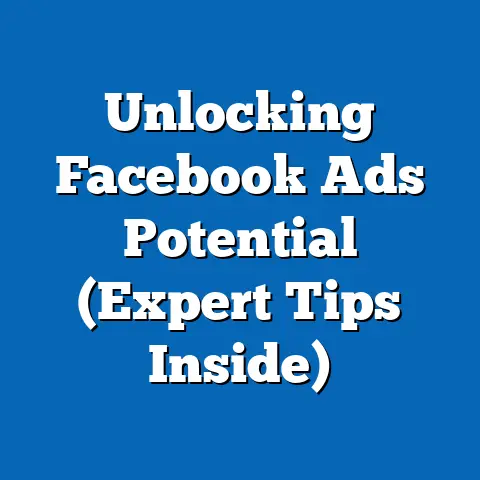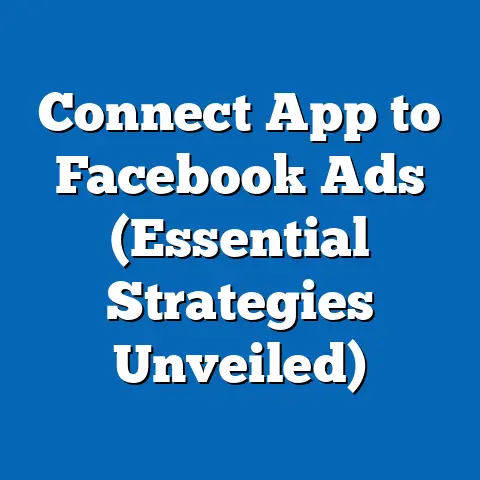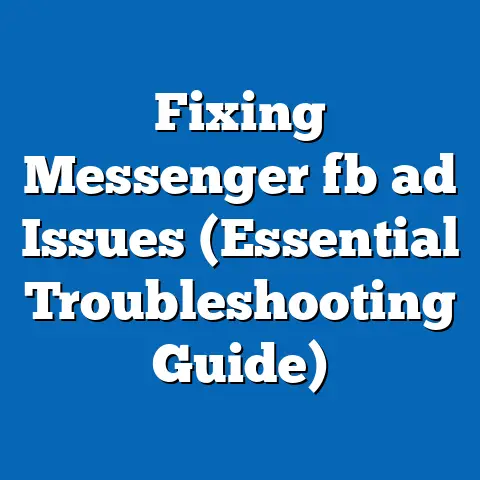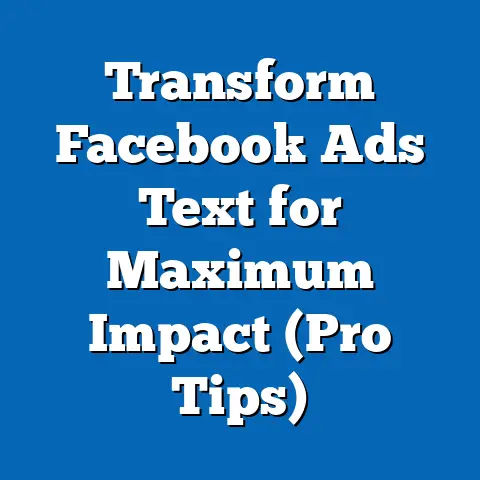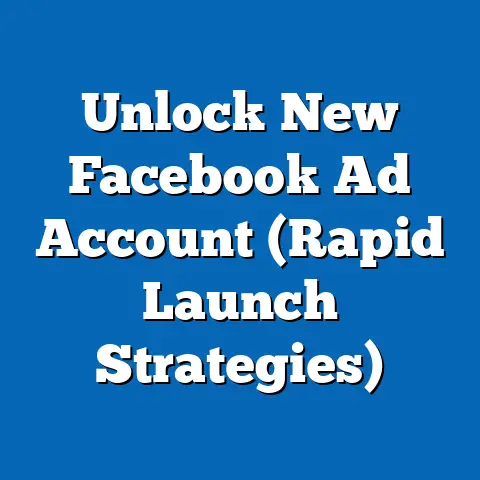Why Ads Outnumber Friends on Facebook (Insightful Analysis)
Facebook, launched in 2004 as a simple social networking platform for college students, has evolved into one of the most versatile and influential digital ecosystems in the world. Initially designed to connect friends and facilitate personal interactions, it has transformed into a multifaceted platform that serves as a social hub, news outlet, marketplace, and advertising juggernaut. This versatility is a defining characteristic of Facebook, reflecting its ability to adapt to user needs, technological advancements, and economic imperatives over nearly two decades.
The societal implications of Facebook’s versatility are profound. It has reshaped how individuals communicate, consume information, and engage with businesses, while also raising questions about privacy, mental health, and the commercialization of personal relationships. One striking trend in recent years is the increasing presence of advertisements on the platform, often outnumbering interactions with friends in users’ feeds. This shift prompts a deeper examination of why ads have become so dominant on Facebook and what this means for users, society, and the future of social media.
The Evolution of Facebook: From Social Connections to Commercial Powerhouse
Facebook’s early appeal lay in its promise of fostering genuine connections. Created by Mark Zuckerberg and his Harvard classmates, it was a space where users could share updates, photos, and messages with friends in a relatively intimate, ad-free environment. This focus on personal interaction was a key differentiator in the mid-2000s, a time when the internet was still transitioning from static websites to dynamic, user-driven platforms.
However, as Facebook grew, so did its ambitions. The introduction of the News Feed in 2006 marked a turning point, centralizing content and paving the way for algorithmic curation. By 2007, the platform launched Facebook Ads, allowing businesses to target users based on demographic data—a move that would fundamentally alter its trajectory. This commercialization accelerated after Facebook’s IPO in 2012, when pressure from shareholders to generate revenue intensified.
Today, advertising is the backbone of Facebook’s business model, accounting for approximately 97% of its revenue, as reported by Meta’s 2022 financial statements. The platform’s ability to collect vast amounts of user data—ranging from likes and shares to browsing habits—has made it an unparalleled tool for targeted advertising. This shift from a social network to a commercial powerhouse reflects broader trends in the digital economy, where user attention is monetized at an unprecedented scale.
The societal impact of this evolution cannot be understated. While Facebook still facilitates personal connections, the increasing dominance of ads has led to user frustration, with many feeling that the platform prioritizes profit over community. Surveys, such as a 2021 Pew Research Center study, indicate that 54% of U.S. adults who use Facebook feel overwhelmed by sponsored content in their feeds. This tension between social purpose and commercial interests lies at the heart of why ads often outnumber friends on the platform.
The Algorithmic Shift: Prioritizing Engagement Over Connection
One of the primary reasons ads dominate Facebook feeds is the platform’s algorithmic design. The News Feed algorithm, which determines what content users see, has evolved over the years to prioritize posts that drive engagement—likes, comments, and shares—over chronological updates from friends. While this was initially intended to surface the most relevant content, it has increasingly favored paid advertisements and viral posts from brands and pages.
According to internal documents leaked in 2021, as reported by The Wall Street Journal, Facebook’s algorithm often amplifies content that generates strong emotional reactions, including anger and outrage, because it keeps users on the platform longer. Ads, which are meticulously crafted to capture attention and elicit responses, often fit this criterion better than personal updates from friends, which may be mundane or less emotionally charged. As a result, users are more likely to see promoted posts than a friend’s vacation photos or status update.
This algorithmic bias is compounded by the fact that organic reach for personal posts has declined significantly. A 2018 study by Buffer found that the average organic reach for a Facebook post from a personal account or small business page is less than 6%, meaning most content shared by friends or non-paying entities is buried in the feed. In contrast, advertisers who pay for visibility are almost guaranteed exposure, further tilting the balance toward ads.
The implications of this shift are significant. Users may feel disconnected from the friends and family they initially joined Facebook to interact with, leading to a sense of alienation. Moreover, the prioritization of engagement-driven content can contribute to echo chambers and misinformation, as sensationalized or polarizing ads often outperform factual or neutral posts. This raises questions about the platform’s role in shaping public discourse and personal relationships in the digital age.
The Business Model: Monetizing Attention in a Competitive Landscape
At its core, Facebook’s dominance of ads over friends is a direct result of its business model, which relies on selling user attention to advertisers. Unlike subscription-based platforms, Facebook offers its services for free, meaning its revenue must come from alternative sources—primarily advertising. In 2022, Meta reported $116.6 billion in revenue, with the vast majority derived from ad sales across its family of apps, including Facebook, Instagram, and WhatsApp.
This model is not unique to Facebook; it reflects a broader trend in the tech industry where user data is the currency of the digital economy. However, Facebook’s scale and sophistication in data collection set it apart. The platform tracks not only on-site activity but also off-site behavior through tools like the Facebook Pixel, allowing advertisers to target users with uncanny precision. For businesses, this makes Facebook an irresistible advertising platform, driving up demand for ad space and, consequently, the volume of ads in user feeds.
The competitive landscape of social media also plays a role. As platforms like TikTok and Snapchat capture younger audiences, Facebook has had to double down on monetization to maintain growth. This has led to an increase in ad frequency and formats, from traditional banner ads to immersive video ads and sponsored Stories. According to a 2023 report by eMarketer, the average Facebook user in the U.S. encounters 12-15 ads per day on the platform, a number that has steadily risen over the past decade.
The societal implications of this ad-centric model are multifaceted. On one hand, it democratizes advertising, allowing small businesses to reach global audiences at a relatively low cost. On the other hand, it commodifies user attention, reducing personal interactions to a secondary role. This dynamic also exacerbates privacy concerns, as users often feel uneasy about the extent of data collection required to fuel targeted ads. A 2022 survey by the Pew Research Center found that 81% of Americans believe the risks of data collection by tech companies outweigh the benefits, highlighting a growing unease with platforms like Facebook.
Generational Dynamics: How Different Age Groups Experience Facebook
Generational differences play a significant role in how users perceive and interact with Facebook, including the prevalence of ads in their feeds. Each generation—Baby Boomers, Gen X, Millennials, Gen Z, and beyond—has distinct historical, cultural, and technological contexts that shape their relationship with the platform. Understanding these nuances is critical to analyzing why ads may outnumber friends for some users more than others.
Baby Boomers (born 1946-1964) grew up in a post-World War II era of economic prosperity and traditional media dominance. Many joined Facebook later in life, often to stay connected with family or reconnect with old friends. While they may be less tech-savvy than younger generations, they are often more tolerant of ads, viewing them as a natural extension of the commercials they encountered on TV and in print. A 2021 AARP survey found that 62% of Boomers use Facebook regularly, and many report using the platform to follow brands or discover products, which may explain why ads resonate with this cohort.
Generation X (born 1965-1980), often dubbed the “forgotten generation,” came of age during the rise of personal computing and the early internet. They adopted Facebook in its early years as a tool for networking and socializing but have since witnessed its shift toward commercialization. Gen X users tend to have a pragmatic view of ads, often ignoring them unless they align with specific interests. However, their feeds may still be dominated by sponsored content due to their active engagement with groups and pages, which are prime targets for advertisers.
Millennials (born 1981-1996) were the first generation to grow up with the internet as a central part of life, and many were early adopters of Facebook during their teenage or college years. Initially drawn to the platform for social connection, Millennials have become increasingly disillusioned with its ad-heavy environment. A 2020 study by Kantar found that 48% of Millennials feel frustrated by the volume of ads on Facebook, with many migrating to platforms like Instagram or TikTok for more authentic interactions. However, their continued use of Facebook for professional networking and marketplace features keeps them exposed to sponsored content.
Generation Z (born 1997-2012), the true digital natives, have a fundamentally different relationship with social media. Having grown up with smartphones and a plethora of platforms, they view Facebook as outdated or irrelevant for personal connections, often associating it with older generations. According to a 2023 Piper Sandler survey, only 27% of U.S. teens use Facebook regularly, compared to 93% for TikTok. For Gen Z users who remain on the platform, ads often dominate their feeds due to low friend activity, as their peers are less likely to post or engage.
These generational trends highlight the diversity of user experiences on Facebook. While ads may outnumber friends across all age groups, the reasons and reactions vary widely. For younger users, the shift reflects a lack of personal engagement, while for older users, it may align with their consumption habits. This disparity underscores the challenge Facebook faces in balancing commercial goals with the diverse needs of its user base.
User Behavior: The Role of Engagement and Declining Organic Interaction
User behavior is another critical factor in why ads outnumber friends on Facebook. Over the years, the way people use the platform has changed, influenced by both internal features and external cultural shifts. These changes have contributed to a decline in organic interaction, creating a vacuum that ads readily fill.
In the platform’s early days, users actively posted status updates, shared photos, and commented on friends’ content. However, as social media evolved, so did norms around sharing. Many users, particularly younger ones, have become more selective about what they post due to privacy concerns and the pressure to curate a polished online persona. A 2019 study by the University of Pennsylvania found that 44% of Facebook users aged 18-29 had reduced their posting frequency over the previous year, citing discomfort with oversharing.
At the same time, passive consumption—scrolling through feeds without liking, commenting, or sharing—has become more common. This “lurking” behavior provides fewer signals to the algorithm about personal connections, making it harder for the platform to prioritize friends’ content. Ads, which are designed to capture attention regardless of user input, naturally rise to the top in such scenarios.
The rise of alternative platforms has also played a role. As users turn to Instagram for visual storytelling, TikTok for short-form entertainment, and messaging apps like WhatsApp for private conversations, Facebook has become less central to personal interaction. This shift reduces the volume of friend-generated content in feeds, leaving more space for sponsored posts. According to a 2022 report by Hootsuite, the average time spent on Facebook per user has declined by 10% since 2018, while ad impressions have increased by 18% over the same period.
The societal implications of these behavioral changes are complex. On one hand, the decline in active engagement may reflect a healthy reevaluation of digital boundaries and privacy. On the other hand, it risks turning Facebook into a passive consumption platform, where users are more likely to encounter commercial content than meaningful interactions. This could further erode trust in the platform and exacerbate feelings of isolation in an already fragmented digital landscape.
Cultural and Economic Factors: The Broader Context of Commercialization
The dominance of ads on Facebook cannot be fully understood without considering broader cultural and economic trends. In the 21st century, the rise of neoliberalism and consumer culture has normalized the commercialization of nearly every aspect of life, including social interactions. Platforms like Facebook operate within this context, where user attention is a commodity to be bought and sold.
Economically, the digital advertising market has exploded, reaching $602 billion globally in 2022, according to Statista. Facebook, as a leader in this space, has capitalized on the demand for targeted advertising, which offers higher returns for businesses than traditional media. This economic incentive drives the platform to maximize ad exposure, even at the expense of user experience. For instance, Meta’s introduction of Reels—a short-form video feature inspired by TikTok—has been accompanied by an influx of sponsored content, as advertisers seize the opportunity to reach users through new formats.
Culturally, the blurring of personal and commercial spaces has become more accepted, particularly among younger generations who have grown up with influencer marketing and branded content. However, this acceptance is not universal. Older users, who remember a less commercialized internet, often express nostalgia for the days when social media was primarily about connection. A 2021 focus group study by the University of Michigan found that users over 50 were more likely to describe Facebook as “cluttered” or “overwhelming” due to ads, compared to younger users who viewed them as inevitable.
The societal impact of these trends extends beyond user experience. The commercialization of social media raises ethical questions about the role of tech companies in shaping culture and behavior. When ads outnumber friends, the platform risks becoming a digital billboard rather than a community space, undermining its original purpose. Moreover, the economic disparity between users (who provide data for free) and corporations (who profit from it) highlights broader issues of inequality in the digital economy.
Implications for Society, Culture, and the Workplace
The prevalence of ads over friends on Facebook has far-reaching implications across multiple domains, from individual well-being to societal dynamics and workplace trends. Understanding these impacts is essential to assessing the platform’s role in modern life.
Societal Implications: The dominance of ads contributes to the commodification of social interactions, where personal relationships are deprioritized in favor of commercial interests. This can exacerbate social fragmentation, as users feel less connected to their communities on the platform. Additionally, the reliance on targeted advertising perpetuates surveillance capitalism, raising concerns about privacy and autonomy in the digital age.
Cultural Implications: Facebook’s ad-heavy environment reflects and reinforces a consumerist culture, where users are constantly encouraged to buy, click, or engage with brands. This can shape values and priorities, particularly among younger generations who are more impressionable. At the same time, the decline in personal content may diminish the platform’s role as a space for authentic self-expression, pushing users toward more curated or transactional interactions.
Workplace Implications: For businesses, Facebook’s advertising dominance offers unparalleled opportunities to reach target audiences, making it a vital tool for marketing and sales. However, for employees and job seekers, the platform’s shift away from personal connection may reduce its utility for networking and professional development. Moreover, the constant exposure to ads can contribute to digital fatigue, impacting productivity and mental health—a growing concern in remote and hybrid work environments.
These implications underscore the need for a balanced approach to social media design, where user experience and commercial goals are not mutually exclusive. While ads are unlikely to disappear from Facebook, their overwhelming presence risks alienating users and undermining the platform’s long-term viability as a social network.
Conclusion: Looking Ahead in an Ad-Dominated Digital Landscape
The phenomenon of ads outnumbering friends on Facebook is a multifaceted issue, rooted in the platform’s business model, algorithmic priorities, user behavior, generational differences, and broader cultural and economic trends. While the shift toward commercialization has enabled Facebook to achieve unprecedented financial success, it has also fundamentally altered the user experience, often at the expense of personal connection. As the platform continues to evolve, balancing these competing interests will be a central challenge for Meta and its stakeholders.
Looking forward, several uncertainties remain. Will users continue to tolerate an ad-heavy environment, or will they migrate to platforms that prioritize authenticity and privacy? Can Facebook innovate in ways that reintegrate personal interactions without sacrificing revenue? And how will emerging technologies, such as artificial intelligence and the metaverse, shape the interplay between ads and friends in virtual spaces?
While definitive answers are elusive, one thing is clear: the dominance of ads on Facebook reflects a broader shift in the digital landscape, where attention is the ultimate currency. As society grapples with the implications of this shift, platforms like Facebook must navigate the tension between profit and purpose, ensuring that the quest for revenue does not eclipse the human connections at the heart of social media. Only by addressing these challenges can Facebook reclaim its role as a space for friends, not just advertisements, in the years to come.

